I am currently trying to work on studying for the ECE NCEE FE exam, but I came across the problem and don't quite understand the answer.
Essentially we have an ideal transformer with an arbitrary load on the secondary side, along with the knowledge that the secondary side is floating, and there is a 120V, 60Hz source on the primary side. Now the question is asked "at which of the following points has the highest risk of electrical shock if a person were to touch the circuit?" (Assuming the person is standing on the ground)
A: Primary side before transformer
B: Primary side GND (after transformer)
C: Secondary side after transformer and before load
D: Secondary side after transformer and load
Now the solution is point A - as point A has an established ground and voltage source (and a shared ground between the circuit and person), so touching point A basically creates a short in the primary side of the transformer, which causes the full source to flow through the person touching it.
What I don't understand is the elaboration of the solution: "...The transformer is ideal, and the load is floating. A fault condition does not exist. Therefore, there is no differential voltage to ground at point C or D."
What I don't understand is how is this possible? Doesn't the transformer provide power to the secondary side, thus creating a flow of current and potential across the load? Wouldn't grabbing point C also be dangerous as well, and possibly D since that node isn't common with earth/person ground - as the potential difference again is basically creating a short when the person touches point C to where they stand?
Basically my confusion is to how the floating side is somehow harmless when you have energy being input from the primary side and creating a potentially dangerous, unknown voltage across the load? I've always been taught that floating circuits are dangerous, not harmless.
